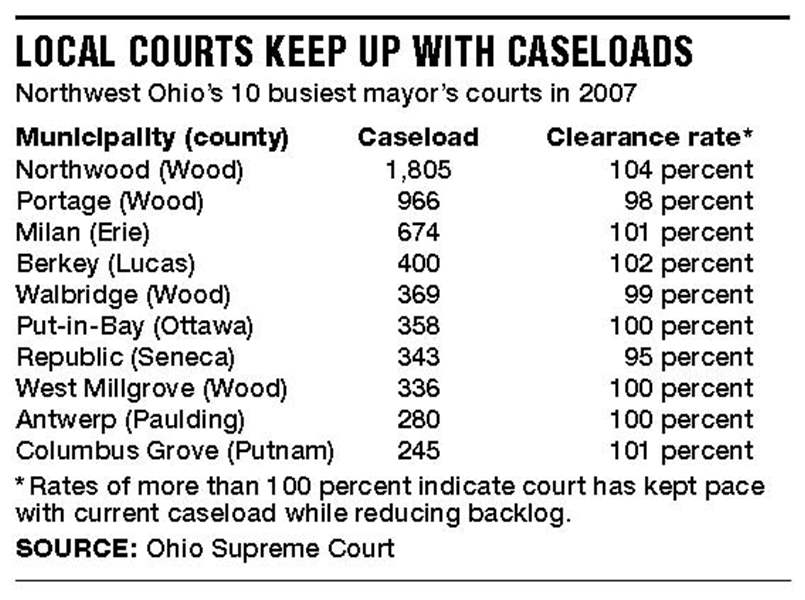
Mayor's courts in Ohio showing backlog of cases
7/18/2008

Moyer
COLUMBUS - Ohio's mayor's courts are falling behind in their caseloads, potentially adding to the arsenal of critics seeking their dissolution.
An annual report released yesterday by the Ohio Supreme Court showed that the small-crime courts over which mayors or their substitute magistrates preside had 4,514 unresolved cases that were more than six months old as of the end of 2007.
That number has nearly tripled since 2004, the first year the courts had to report statistics to the Supreme Court.
John Mahoney, spokesman for the Ohio Municipal League, was at a loss to explain why mayor's courts are falling behind. The league has been a staunch defender of the courts, which deal with local ordinance and traffic violations.
"When I last surveyed mayor's courts, 90 percent of cases are simple guilty pleas," said Mr. Mahoney. "You get a ticket and pay for it. How we would have that kind of increase in old cases, I have no idea."
Legislation has been routinely introduced in recent years to do away with Ohio's 355 mayor's courts and distribute their caseloads to other courts under the Supreme Court's supervision. The bills have gone nowhere.
The latest version, House Bill 154, was introduced more than a year ago. It would abolish the courts but allow for the creation of far fewer "community courts" in larger municipalities to be administered by attorney magistrates.
"The biggest problem in moving all cases to municipal court is it increases the cost of law enforcement," said Mr. Mahoney. "You may have to send police officers 20 miles away to testify, usually at time and a half."

Supreme Court Chief Justice Thomas Moyer has been among the biggest critics of mayor's courts, questioning the propriety of a chief executive of a municipality levying fines paid into a general fund over which he has some control.
He said the backlog statistic took him by surprise.
"That's one of the reasons that mayors have given for wanting to keep the system as it is, that's it's very efficient and people can get in and out quickly," he said. "These numbers are contrary to that claim."
He said he hopes the latest bill will see at least a House vote during the few remaining weeks left in the session when lawmakers return to Columbus after the Nov. 4 election.
Ohio and Louisiana are the only states that still have mayor's courts. In Ohio, municipalities that have more than 100 residents but no municipal courts of their own may employ mayor's courts.
There is no requirement that a mayor acting as a judge be an attorney, but communities are increasingly turning to professional magistrates to handle cases.
House Bill 154 would allow communities with 1,600 or more people to create community courts. A little more than half of the communities that now have mayor's courts would not qualify. The bill would exempt current courts on Lake Erie islands, such as Kelley's Island and Put-in-Bay, from the minimum population requirement.
As of the end of 2006, mayor's courts still had 22,986 unresolved cases on their books. A year later, that number had climbed to 26,846. Of those, 4,514, or nearly 17 percent, were older than the recommended time limit of six months.
According to the report, Berkey, the sole mayor's court in Lucas County, has managed to keep up with its caseload, which amounted to about 1.5 cases for every person who lives there. Berkey, like many other mayor's courts, had clearance rates at or above 100 percent, indicating they were keeping pace with the number of new cases while also reducing backlogs.
Other communities, however, dragged down the statewide averages. The lowest caseload clearance rate reported statewide belonged to Matamoras in southeast Ohio's Washington County, which cleared just 32 percent of its cases.
Jefferson County's Mingo Junction, at 50 percent, had the second lowest rate. Magistrate Costas Mastros was surprised at the number, saying he believes the figure may reflect the fact that his office considers a decided case to still be active if fines have yet to be fully paid.
"That is probably the reason," he said. "I know there's not 50 percent waiting for me to make a decision. There might be five cases total."
The lowest clearance rates of cases among the mayor's courts in northwest Ohio belonged to Kelleys Island in Erie County and North Baltimore in Wood County. Both finalized 86 percent of their caseloads.
Contact Jim Provance at:
jprovance@theblade.com
or 614-221-0496.